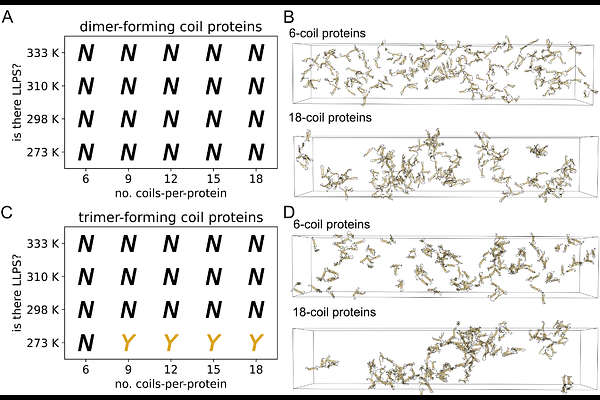Nonspecific interactions can lead to liquid-liquid phase separation in coiled-coil proteins models

Nonspecific interactions can lead to liquid-liquid phase separation in coiled-coil proteins models
Ramirez, D. A.; Shrimpton, A.; Shirts, M. R.; Hough, L. E.
AbstractLiquid-liquid phase separation (LLPS) is one mechanism that cells can use to organize biomolecules spatially and functionally. Some coiled-coil (CC) proteins, such as the centrosomal proteins pericentrin and spd-5, are thought to LLPS, but it is currently unknown what parts of these proteins facilitate the process. It is thought, however, that the numerous CC domains in these proteins might be contributing to their LLPS. We recently showed, using computational studies and designed proteins, that CC domains can facilitate LLPS through specific interactions between the CC domains themselves, meaning that each CC was designed to interact only with a subset of other CCs in the system. This is in contrast to nonspecific interactions, where all CCs would be able to interact with all other CCs in the system, which is akin to some interactions (e.g. {pi}--{pi}) seen in phase-separating intrinsically disordered proteins. Because the specificity of interactions between natural CC domains is tunable in a sequence-dependent fashion, CC domains present a unique system that allows us to investigate the contributions of specific versus nonspecific interactions on LLPS. We show, in our computational system, that CC proteins with nonspecific interactions can LLPS but with less propensity compared to specific interactions. The LLPS propensity of CC proteins with nonspecific interactions can be improved by altering the structure and dynamics of linker segments, without directly changing the specificity of interactions. We also demonstrate that the number of intra-chain CC contacts plays a direct role in determining LLPS for nonspecifically interacting proteins. These results have broad implications for the role of linker segments---protein features beyond the interaction domains e.g. \'stickers\'---in protein LLPS and the formation of biomolecular condensates.